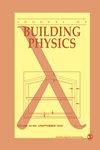Influence of variability in hygrothermal properties on analytical results of simultaneous heat and moisture transfer in porous materials
IF 1.4
4区 工程技术
Q3 CONSTRUCTION & BUILDING TECHNOLOGY
引用次数: 4
Abstract
Depending on the data source used, the material hygrothermal properties that are used in the numerical analysis of simultaneous heat and moisture transfer will not be consistent. Differences in measurement methods and the individuality of specimens account for this. It is necessary to choose values from these different physical property sets to conduct a numerical calculation, which can cause the calculated results to differ. The subsequent range of variation in the calculated results should be quantitatively evaluated. In this study, the physical properties of several types of porous building materials were first gathered from four databases. The data were then categorized based on the kind of material and compared in terms of each physical property (density, porosity, specific heat, moisture capacity, thermal conductivity, and vapor permeability). The density, porosity, and specific heat varied by 10% on average, and the moisture capacity, thermal conductivity, and vapor permeability varied by 20% or more for all types of materials. In particular, the vapor permeability of plywood and moisture capacity of gypsum board differed by 50%. The influence that these physical property value variations had on hygrothermal calculation results was then quantitatively demonstrated for moisture and heat flow rate under a step change in the relative humidity or temperature of indoor air for a single layer wall. The moisture and heat flow rate into a single layer wall fluctuated by approximately 10%–40% due to differences in the vapor permeability and moisture capacity of the materials. For all types of materials, moisture was transferred more slowly than heat. Therefore, differences in moisture property values, such as vapor permeability and moisture capacity, influenced the results more significantly. Moreover, the moisture flow was accompanied by a phase change. The differences in moisture property values thus affected the heat flow.湿热特性变化对多孔材料热湿同步传递分析结果的影响
根据所使用的数据源,用于同时热湿传递的数值分析的材料湿热特性将不一致。测量方法的差异和标本的个性说明了这一点。需要从这些不同的物理性质集合中选择数值进行数值计算,这可能导致计算结果不同。计算结果的后续变化范围应进行定量评价。在本研究中,首先从四个数据库中收集了几种多孔建筑材料的物理性质。然后根据材料的种类对数据进行分类,并根据每种物理性质(密度、孔隙率、比热、湿容量、导热系数和透气性)进行比较。对于所有类型的材料,密度、孔隙率和比热平均变化10%,湿容量、导热系数和透气性变化20%或更多。特别是胶合板的透气性与石膏板的吸湿性相差50%。这些物理性质值的变化对湿热计算结果的影响,然后定量地证明了在室内空气相对湿度或温度阶跃变化下的湿热流率。由于材料的透气性和吸湿能力不同,进入单层壁面的水分和热流率波动约为10%-40%。对于所有类型的材料,水分的传递都比热量的传递慢。因此,湿性值(如透气性和湿容量)的差异对结果的影响更为显著。此外,水分流动还伴随着相变。水分特性值的差异影响了热流。
本文章由计算机程序翻译,如有差异,请以英文原文为准。
求助全文
约1分钟内获得全文
求助全文
来源期刊

Journal of Building Physics
工程技术-结构与建筑技术
CiteScore
5.10
自引率
15.00%
发文量
10
审稿时长
5.3 months
期刊介绍:
Journal of Building Physics (J. Bldg. Phys) is an international, peer-reviewed journal that publishes a high quality research and state of the art “integrated” papers to promote scientifically thorough advancement of all the areas of non-structural performance of a building and particularly in heat, air, moisture transfer.
 求助内容:
求助内容: 应助结果提醒方式:
应助结果提醒方式:


